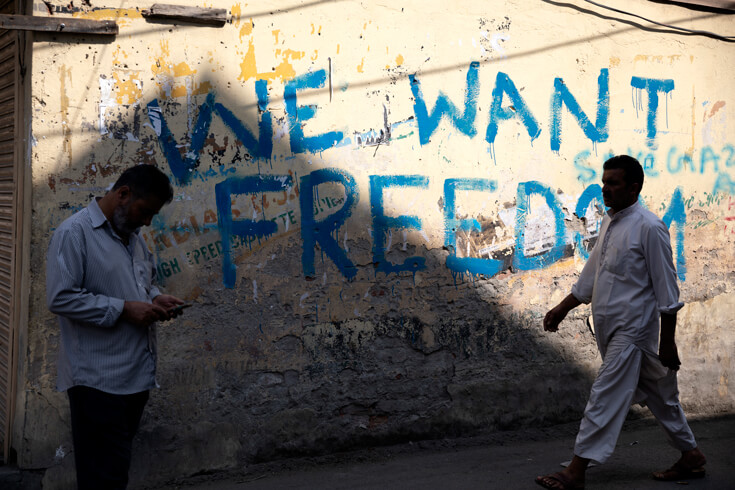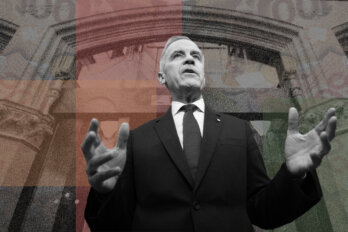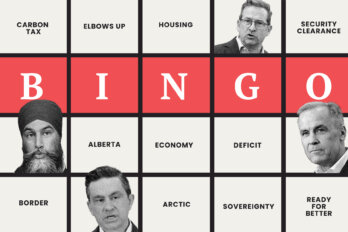The last time I was in Kashmir, I had to be smuggled to my uncle’s house, under the dashboard of a transport truck, with my mother and sister. It was 1988, I was thirteen years old, and we had asked somebody to take us to a safer location. I had been travelling to visit my extended family in Srinagar. It was my fifth time visiting the capital city, but this trip was different. Usually, we could take a taxi or a rickshaw across town. Now, the military-enforced curfew restricted our movements. It was getting dark, but my mom risked the move. She didn’t like the atmosphere building in the city, and my uncle’s house was closer to the Srinagar airport. Because of the imposed curfew, she also feared we wouldn’t make it to the airport in time for our flight the next day.
That year, tensions between neighbours were high, boosted by a recent state election that the Muslim population—which makes up the majority in Kashmir—believed had been rigged against it. Rajiv Gandhi, the prime minister at the time, was barely holding the country together. I don’t remember being scared as we crossed the checkpoints: I imagined we were on an adventure. I do remember how tense my mother was beside me, though, and how tightly she held onto my younger sister whenever the truck slowed down.
As Hindus, we were in danger of being turned back or arrested at one of the state’s checkpoints. This cycle of violence was not new for many in Kashmir, and it has not ended. State curfews and border shutdowns are a way of life for many Kashmiri to this day. The target may shift, but the conflict has remained relatively consistent. More than three decades ago, I was hidden in the truck. But, at another point in history, it could equally have been my Muslim counterpart or my Sikh peer. The harm done by historical geographic cuts made to India and Pakistan, based on a British interpretation of religious nationalism, has only deepened over the years—largely fuelled by the divisive words and actions of politicians on many sides.
Today, prime minister Narendra Modi is only the latest right-wing populist to come into power in India. Like other nationalist leaders around the world, his India-first platform includes an emphasis on excluding the people he considers outsiders. Since his first election win, in May 2014, Modi has used antiterrorism and antisedition laws to prosecute lawyers, activists, journalists, and academics in a move that Human Rights Watch has criticized. In Kashmir alone, he has arrested thousands of people he considers dissidents, and the Indian military roams the deserted streets. What’s more, since August 5, Modi has enacted both communications blackouts and curfews in Kashmir.
Elsewhere, world leaders have condemned populism and nationalism. Justin Trudeau has publicly criticized both Brexit and US President Donald Trump. Stories on the dangerous divisiveness being stoked in those countries have dominated our headlines for years. Yet Modi, by comparison, has faced little backlash on the world stage over his actions in Kashmir. His abuses of power are rarely front-page news. Surely, though, his form of nationalism should be no more acceptable than Trump’s or Maxime Bernier’s or Matteo Salvini’s. So why aren’t more people outside of India rising up to condemn it? More to the point: Why have they never?
Kashmir is a picturesque place, but its beauty belies a long history of political and social upset. In the fourth century, the Kashmir Valley was the seat of Buddhism. Elsewhere in the world, Constantine was popularizing Christianity in Rome, the Teotihuacan empire was flourishing in South America, and the Jin dynasty was fighting the northern tribes in China. Accordingly, while a succession of Hindu kings ruled Kashmir from the fourth to thirteenth centuries, they had to continuously fight against outside threats from the Huns, Arabs, and Persians. In 1339, Shah Mir overthrew the state’s last Hindu ruler, Queen Kota Rani, becoming the first Muslim to establish a dynasty.
For the next four centuries, a Muslim ruler held power in Kashmir. That ended in 1819, when the Sikhs annexed the land and persecuted the Muslim population for decades, restricting their religious practices. After losing to the British in the first Anglo-Sikh war, nine-year-old leader Dalip Singh was forced to sign the Treaty of Lahore, an agreement that led to the transfer of Jammu and Kashmir into the hands of the British East India company. Much later, in 1947, the British split the subcontinent into India and Pakistan, making Kashmir, cradled between the two new countries, a point of contention. But the cyclical nature of power in the area has never ceased—and neither has the shifting nature of suffering. Shortly after what would be my last trip to Srinagar, my family was forced to leave their homes in the middle of the night, with only the clothes on their backs, because they were Hindu. Now, it’s the Muslim population that’s suffering in India.
Growing up in the late 1970s and ’80s, I remember hearing about how prime minister Indira Gandhi ordered soldiers and tanks into the Golden Temple complex in Amritsar, located in Punjab—sparking a new cycle of violence that continued for months. Called Operation Blue Star, the move was meant to flush out a militant Sikh leader named Jarnail Singh Bhindranwale, who supported the Khalistan Sikh separatist movement and was thought to be responsible for several religiously motivated murders in India. Nearly 1,000 people, by some estimates, were killed before the Khalistan militants were apprehended. Sikhs retaliated, killing Hindus in uncoordinated attacks all over the country. The conflict culminated in the assassination of Indira Gandhi, five months after the raid, by her Sikh bodyguards. Like Americans with 9/11, every Indian remembers where we were October 31, 1984—the day of her assassination. Over the next few months, thousands of Sikhs were killed in the resulting riots.
This was the India I would visit in my youth. According to my parents, it was just another spoke in the wheel of conflict and violence—one that would not stop turning. I may have grown up hearing about Indira Gandhi, but my mother grew up hearing about the time directly after partition, when it is estimated that approximately 75,000 women of all faiths were kidnapped and raped. Unbeknownst to me, that is what was going through her mind as she hid us in that truck that day. This isn’t to say, however, that everything has always been bad in Kashmir.
On a day-to-day basis, with no political figures to exploit historical tensions, many Kashmiri of different faiths live and work alongside one another. For decades after partition, Hindus, Sikhs, and Muslims lived in relative peace. My cousins learned from Sikh, Muslim, Hindu, and Christian teachers. Marriages between people of different religions took place in my family, and while they were not exactly celebrated, they were accepted. Despite the conflict, people were still human: they formed bonds and built communities, even across religious lines.
Still, my family could not escape the wider conflict in Kashmir. In the 1990s, many Kashmiri Hindus fled the state, leaving behind them the violent attacks that had targeted families like mine. Many members of my family fled too, running from the only home they had ever known. Most have never returned. Like all refugees, their displacement was traumatic and horrible, but thankfully, unlike many who had been driven out of Kashmir, no one in my family was hurt. Most of my uncles assumed they’d be back at their jobs and in their homes within the next few months—at most, a year. But that’s not what happened. They never went home. They were compensated by the Indian government and forced to make new lives somewhere else.
Between 1947 and today, India has had fifteen prime ministers, and half a dozen have had some pro-Hindu tendencies. The current party in power is the Bharatiya Janata Party (also referred to as BJP or the Indian People’s Party). Yet India is touted as one of the “good” countries: democratic, capitalistic, and forward-thinking. It loves to call itself the largest democracy in the world, but can you really call yourself a democracy when your government has been favouring one religion over all others for decades? This isn’t a blip or the reaction of an angry group of the electorate that feels forgotten by the government. This is a systemic focus on creating a state with a single ruling religion.
In our current moment, it’s the Hindus, which seems to be more palatable to the rest of the world than the possibility of an India under Muslim rule. Rising Islamophobia has surely contributed to this, making it increasingly politically acceptable to discriminate against people of the Muslim faith. When it comes to India, it feels like the constant cycling of power is now in sync with the larger world’s prejudice. Modi is discriminating against Muslims—but so are many other countries. Canada has not escaped Islamophobia, and nor did its election cycle. Recently, in Brampton, Ontario, a screaming woman accused NDP leader Jagmeet Singh of supporting Sharia law. No one, including Singh (who is Sikh, not Muslim), seemed surprised by the hateful outburst. In other words, there’s a reason Modi seems to be getting away with anti-Muslim nationalism.
He has made no secret of his new citizenship bill, which proposes to treat Hindus and Sikhs who live in India one way and Muslims who live there another. He has also demoted Kashmir from a state to a union territory—something that’s never been done before in India. This demotion gives more power to the federal government (i.e., Modi), stealing it away from previously autonomous local leaders. Indians from anywhere in the country can now buy land and set up homes in Kashmir, which wasn’t previously possible, potentially allowing non-Kashmiri Indians to flood the housing market. This could drive up prices and snap up available real estate, making it more difficult for Muslims to access land and housing. Furthermore, in the face of such discriminatory treatment, Muslims who do own land in Kashmir may now feel pressured to sell.
Some of my family is celebrating Modi’s actions (most noticeably my American relatives, who live in Connecticut). Others are arguing against them: they believe that subverting the rights of any Kashmiri (or any citizen anywhere in the world) based on their religion is never going to solve anything. Personally, I’d like to believe that, in Kashmir, peace and equality are possible. Whenever I think of the Kashmir I’d like to see, I think of a story my father tells from when I was a toddler visiting my nanni. I would wake up early with my dad, and we’d walk from the house to the local market, past fields of rice. On one of these excursions, we were standing in line with a tin container to get our serving of milk for the day. In front of us, there was someone wearing a lungi (basically a wrapped skirt). They had wet, unbound hair, drying in the morning sun. Their hair was black and curly and very long, reaching down to their hips.
When the hair bearer turned to look down at the babbling toddler in line behind them, I began to yell. As my father tells it, I shouted, “That woman is a man! THAT WOMAN IS A MAN!” My father had to scoop me up and flee the market in embarrassment. The person standing in front of us was a Sikh gentleman with a full beard and, not having been raised in Kashmir like my parents were, I’d never seen anyone like him. As an adult, however, the detail from this story that sticks with me is different: the line of people of every culture waiting their turn in a marketplace where we all belonged. I believe that could be a reality again in Kashmir. That is, if politicians would stop pitting us against one another based on our religions—if there wasn’t always someone like Modi plucking the strings of nationalism. Then, maybe, the picturesque postcards of my homeland could finally match the reality of living there.





